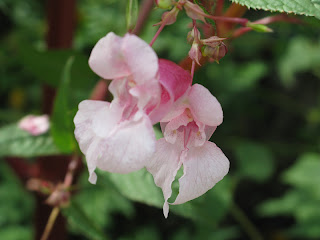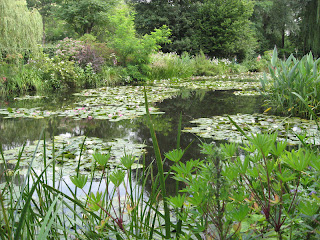Thouars Encore
Our home away from home
Thursday, August 30, 2012
Chapter Ends
After a three-month adventure in France, from Poitou-Charentes and the Loire, to Brittany and Normandy, my travel chapter ends and I turn the page. From May 14 - August 9, 2012, I experienced a short time-capsule of what living in France means. It certainly means a buffet of landscapes, architecture, music and cultural events, and it most definitely means a feast for the tastebuds.
Life in France may be less luxurious than Canada by the standard measures we often use - the houses are older and smaller, the cars more compact, the utilities pricey - but it often feels richer in quality, more textured, more civilized. It is easy to take pleasure from the simple moments there. Whether relaxing over an extended lunch break, feeling calm driving on roads with considerate drivers, or enjoying a museum or exhibit seen nowhere else in the world, I feel part of something special, having an experience I don't want to end.
One of the best aspects of France is its food! Magazine articles have forever lauded this feature of France, but I'm not speaking only of high-end Paris restaurants with big price tags. I'm speaking about the quality, the presentation, the taste and the experience of food in those smaller centres throughout France. Not only do the restaurants serve top quality meals, but the everyday purchases made in the local grocery stores or weekly markets are beyond compare to what I am used to. The produce is fresh, no doubt, but it TASTES like it used to about 50 years ago in Canada, when I would pluck a ripe tomato from my mother's garden, or went berry-picking with my grand-mother. Back in the time when there were no pesticides and herbicides, no genetic engineering, no hormone injections... I shopped in a local Canadian farmer's market just last week where everything was organic, and still, things were not the same as in France. Without wanting to open a political debate, I hope that France will continue to adhere to its strict regulations on agriculture and imports. Free trade would be a disaster for the French food industry.
Was there a highlight in all we visited? Karl certainly loved Giverny and insisted I include in my blog almost every flower he photographed (although there are still a few hundred not downloaded), but I am finding it difficult to pinpoint one particular event or time that stood above the rest. It is probably a collage of people watching, pink champagne and beautiful strands of music. It's a lasting memory of enjoying my brother Gérard and his family coming to share some time with us in Thouars, of Emélie discovering hot chocolate and croissants and Charlotte strawberries, of Karl and I getting in the car and allowing the road to lead us to something new. It's of the friends we made along the way, the chefs who came out to chat, the gentle lady who commiserated with us in Richelieu, the smile on a face when that person realized we spoke their language with an accent and funny expressions, the butcher who took special care to prepare a roast and presented it with such pride. It's the wild and wonderful waves of Saint-Malo, the cows that look made-up with their long lashes and dark eye shadow, and the tears shed on D-Day. These snippets come together and make me appreciate the French people, make me hope that I will one day go back to explore yet another region of this wonderful country.
Karl and I feel "at home" in France. We have been there three times for extended stays and feel we know the country well, yet have only skimmed the surface of what it has to offer. One day, God willing, we will be back. Till then, we will replay the memory recordings of our adventure and say - merci! Au revoir.
Thank you to all my readers who so faithfully followed this blog. It was a pleasure for me to write with the knowledge that you were out there, living this journey vicariously through my musings. Your comments and emails meant so much. I sign off in the hope that we will connect again. À la prochaine!
Should you wish to read the blogs from previous trips:
http://france-encore.blogspot.com (Thouars, Poitou Charentes, May 2010)
http://two-months-in-france.blogspot.com (Languedoc/Roussillon, April 2009)
http://36-daycruise.blogspot.com (Panama Canal and the Amazon, November 2008)
Sunday, August 26, 2012
Impressions of Giverny
We visited two museums in Giverny: the Museum of Impressionisms Giverny, and the better-known Fondation Claude Monet.
 |
| Degas: Les repasseuses |
The Museum of Impressionisms Giverny focuses on all the different forms of Impressionism, one of the most popular painting movement. Its origins, its geographical diversity, its history and development in other streams, are the themes the museum deals with. Because Giverny is not only an essential stop on an impressionist route in the Seine Valley, it is also a crucial landmark in the turn from Impressionism to the art of the 20th century.
Our main goal was to visit Monet's gardens, as we refer to La Fondation Claude Monet. It was magnificent and Karl felt it was a highlight of his trip to France this year. The ambiance is calm, peaceful and you feel at one with your surroundings. No wonder Monet was able to produce such impressive work.
At the beginning of May 1883, Monet and his family rented a house and 2 acres from a local landowner. The house was situated at Giverny. There was a barn that doubled as a painting studio, orchards and a small garden.
The house is decorated in the colour schemes that Monet admired.
Claude Monet (14 November 1840 – 5 December 1926) was a founder of French impressionist painting, and the most consistent and prolific practitioner of the movement's philosophy of expressing one's perceptions before nature, especially as applied to plein-air landscape painting. The term Impressionism is derived from the title of his painting Impression, Sunrise (Impression, soleil levant).
Each flowerbed has a colour scheme that contributes to the look of the whole garden.
The family worked and built up the gardens and Monet's fortunes began to change for the better. By November 1890, Monet was prosperous enough to buy the house, the surrounding buildings and the land for his gardens.
Look at the luminosity coming from this flower! One almost thinks there's a light bulb at its core.
Monet was fond of painting controlled nature: his own gardens in Giverny, with its water lilies, pond, and bridge. He wrote daily instructions to his gardener, precise designs and layouts for plantings, and invoices for his floral purchases and his collection of botany books. As Monet's wealth grew, his garden evolved. He remained its architect, even after he hired seven gardeners.
The Water Garden starts with a huge growth of bamboo.
The Water Garden path meanders under weeping willows, over the Japanese bridge, and around the pond filled with water lilies, a plant we most closely associate with Monet. The eye sets on countless scenes that leave artists aching for an easel.
Even the ducks appreciate the lilies in the Water Garden pond.
Subscribe to:
Posts (Atom)
























































